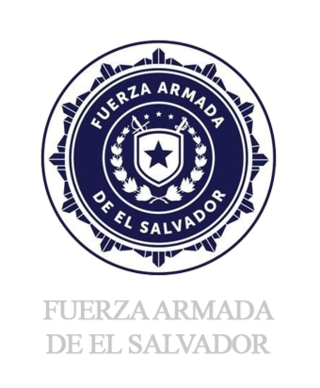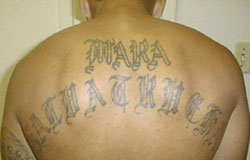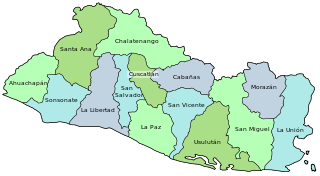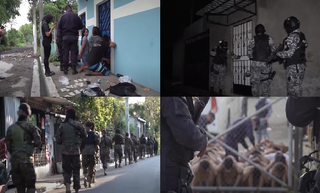Related Research Articles

The Armed Forces of El Salvador are the official governmental military forces of El Salvador. The Forces have three branches: the Salvadoran Army, the Salvadoran Air Force and the Navy of El Salvador.
Politics of Guatemala takes place in a framework of a presidential representative democratic republic, where by the President of Guatemala is both head of state, head of government, and of a multi-party system. Executive power is exercised by the government. Legislative power is vested in both the government and the Congress of the Republic. The judiciary is independent of the executive and the legislature. Guatemala is a Constitutional Republic.

The 18th Street Gang, also known as Calle 18, Barrio 18, Mara 18, or simply 18 in North America, is a multi-ethnic transnational criminal organization that started as a street gang in Los Angeles. It is one of the largest transnational criminal gangs in Los Angeles, with 30,000-50,000 members between the United States, Mexico, and Central America and is also allied with the Mexican Mafia, another US-based crime organization. A United States Department of Justice report featured the following statement regarding 18th Street and rival gang MS-13, "These two gangs have turned the Central American northern triangle into the area with the highest homicide rate in the world."

Crime and violence affect the lives of millions of people in Latin America. Some consider social inequality to be a major contributing factor to levels of violence in Latin America, where the state fails to prevent crime and organized crime takes over State control in areas where the State is unable to assist the society such as in impoverished communities. In the years following the transitions from authoritarianism to democracy, crime and violence have become major problems in Latin America. The region experienced more than 2.5 million murders between 2000 and 2017. Several studies indicated the existence of an epidemic in the region; the Pan American Health Organization called violence in Latin America "the social pandemic of the 20th century." Apart from the direct human cost, the rise in crime and violence has imposed significant social costs and has made much more difficult the processes of economic and social development, democratic consolidation and regional integration in the Americas.

Mara Salvatrucha, commonly known as MS-13, is an international criminal gang that originated in Los Angeles, California, in the 1980s. Originally, the gang was set up to protect Salvadoran immigrants from other gangs in the Los Angeles area. Over time, the gang grew into a more traditional criminal organization. MS-13 has a longtime rivalry with the 18th Street gang.
Crime in Honduras has become a growing matter of concern for the Honduran population in recent years. Honduras has experienced alarmingly high levels of violence and criminal activity, with homicide rates reaching a peak in 2012, averaging 20 homicides per day. Corruption, extortion, coercion, and drug smuggling also run rampant throughout Honduran society, preventing the nation from building trustworthy authorities like police, and severely limiting economic, social, or political progress. The situation has prompted international organizations and governments to offer assistance in combating crime in Honduras.
Rates of crime in Guatemala are very high. An average of 101 murders per week were reported in 2018. The countries with the highest crime and violence rates in Central America are El Salvador and Honduras. In the 1990s Guatemala had four cities feature in Latin America's top ten cities by murder rate: Escuintla, Izabal (127), Santa Rosa Cuilapa (111) and Guatemala City (101). According to New Yorker magazine, in 2009, "fewer civilians were reported killed in the war zone of Iraq than were shot, stabbed, or beaten to death in Guatemala," and 97% of homicides "remain unsolved." Much of the violent nature of Guatemalan society stems back to a 36-year-long civil war However, not only has violence maintained its presence in the post-war context of the country following the Guatemalan Civil War, but it has extended to broader social and economic forms of violence.
Counter-flow refers to the movement of culture that runs counter to the traditional dominant-to-dominated cultural adaptation patterns. In a contraflow situation, cultural elements brought into a society by immigrants become accepted and popular among the society at large. Examples include the world-wide popularity of telenovelas, anime and K-Pop.

Crime in El Salvador has been historically extremely high due to the presence of various gangs. As of 2011, there were an estimated 25000 gang members at large in El Salvador; with another 43500 in prison. The best-known gangs, called maras in colloquial Salvadoran Spanish, are Mara Salvatrucha (MS-13) and their rivals 18th Street; maras are hunted by death squads, including Sombra Negra. Newer rivals include the rising mara, The Rebels 13. El Salvador is one of the three countries of the Northern Triangle of Central America, along with neighboring Guatemala and Honduras, which are all afflicted with high levels of violence.

The nations of El Salvador and Mexico established diplomatic relations in 1838. Both nations are members of the Association of Caribbean States, Community of Latin American and Caribbean States, Organization of American States, Organization of Ibero-American States and the United Nations.

Salvadorans are the second largest Hispanic group in the United States and the second largest foreign born group in Los Angeles. The main wave of immigrants came during the Salvadoran Civil War in the 1980s, in order to escape the violence and political and economic instability in the country. Since then, Salvadorans have continued to migrate to Los Angeles as well as other cities around the United States. The community is well established in Los Angeles and stands as an integral part of its cultural and economic life.
La Mano Dura is a set of tough-on-crime policies put in place by the Salvadoran government in response to the problem of gang violence. These policies were put in place in response to popular calls for the government to do something about the problem of rampant crime. La Mano Dura policies have come under criticism due to human rights concerns.
Transnational gangs can be described as gangs that are located in multiple countries. When these gangs commit crimes in one country, their plans for the crime can sometimes be put together in another country. These gangs or mara are able to move around efficiently from one place to another. Transnational gangs are not a normal street gang because they are much larger in size and located in more than one country; they are considered to be able to pose a significant threat for the safety of the countries they are located in.

The Northern Triangle of Central America (NTCA) is a term used in the United States to refer collectively to the three Central American countries of Guatemala, Honduras, and El Salvador. The term is used with respect to the countries' economic integration, and their shared challenges, including widespread poverty, violence, and corruption, which have prompted many to become refugees fleeing the three nations.

Sex trafficking in El Salvador is human trafficking for the purpose of sexual exploitation and slavery that occurs in the Republic of El Salvador. It is a country of origin, transit, and destination for sexually trafficked persons.
Over time, there has been an increase in sex trafficking in Central America. Because of the lack of financials, work opportunities and studies, women and men see sex work as the solution to their problems. In addition, the living conditions, poverty, and gang violence are the reason as to why a lot of people have been coerced into sex trafficking. These countries are working with their government and other countries in order to create laws to fight against sex trafficking.

The Salvadoran gang crackdown, referred to in El Salvador as the régimen de excepción and the guerra contra las pandillas, began in March 2022 in response to a crime spike between 25 and 27 March 2022, when 87 people were killed in El Salvador. The Salvadoran government blamed the spike in murders on criminal gangs in the country, resulting in the country's legislature approving a state of emergency that suspended the rights of association and legal counsel, and increased the time spent in detention without charge, among other measures that expanded the powers of law enforcement in the country.

The blockade of Soyapango was a Salvadoran government operation to arrest criminal gang members of Mara Salvatrucha (MS-13) and 18th Street gang in the city of Soyapango. The operation began on 3 December 2022 when Salvadoran President Nayib Bukele announced that 10,000 members of the country's security forces surrounded the city. As of January 2023 the active phase of the blockade has been completed; however, security forces are still engaged in removing gang related symbols and the security setup in the area has been enhanced.

The Terrorism Confinement Center is a maximum security prison located in Tecoluca, El Salvador. The prison was built from July 2022 to January 2023 amidst a large-scale gang crackdown in El Salvador. CECOT was opened by the Salvadoran government in January 2023 and received its first 2,000 prisoners in February 2023.

The blockade of the Cabañas Department was a military operation in El Salvador during the Salvadoran gang crackdown which started on 1 August 2023, when Salvadoran President Nayib Bukele announced that 7,000 soldiers of the Armed Forces of El Salvador (FAES) and 1,000 police officers of the National Civil Police (PNC) had surrounded the department of Cabañas to capture gang members within the department.
References
- ↑ Stephen Castles, Raúl Delgado Wise (2007). "Migration and Development: A Conceptual Review of the Evidence". Migration and Development: Perspectives from the South. Geneva: International Organization for Migration (IOM). p. 33. Archived from the original on 2014-05-09. Retrieved 2014-04-19.
- ↑ Bruneau, Thomas; Dammert, Lucia; Skinner, Elizabeth (2011). Maras: Gang Violence and Security in Central America. University of Texas Press. p. 2. Retrieved May 12, 2024.
- ↑ Bruneau, Thomas; Dammert, Lucia; Skinner, Elizabeth (2011). Maras: Gang Violence and Security in Central America. University of Texas Press. p. 24-30. Retrieved May 12, 2024.
- 1 2 Boraz, S.C.; Bruneau, T.C. (2006). "Are the maras overwhelming governments in Central America?" (PDF). Calhoun:The NPS Institutional Archive. Retrieved 2021-08-26.
- ↑ Does, Antonia (2013). "2. The Central American gang phenomenon". The construction of the maras. ECahiers de l'Institut. Graduate Institute Publications. ISBN 9782940503353 . Retrieved 2021-09-22.
- ↑ Bruneau, Thomas; Dammert, Lucia; Skinner, Elizabeth (2011). Maras: Gang Violence and Security in Central America. University of Texas Press. p. 43. Retrieved May 12, 2024.
- ↑ Bruneau, Thomas; Dammert, Lucia; Skinner, Elizabeth (2011). Maras: Gang Violence and Security in Central America. University of Texas Press. p. 68-69. Retrieved May 12, 2024.
- ↑ "Maras criminal gangs". City Mayors Foundation. 2006-07-26. Retrieved 2013-03-15.
- ↑ Mar 1999 USCIS publication QA/SLV/99.001 Archived 2009-06-27 at the Wayback Machine , esp pg. 6 citation #14.